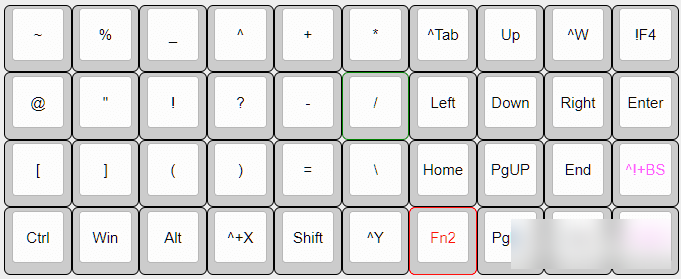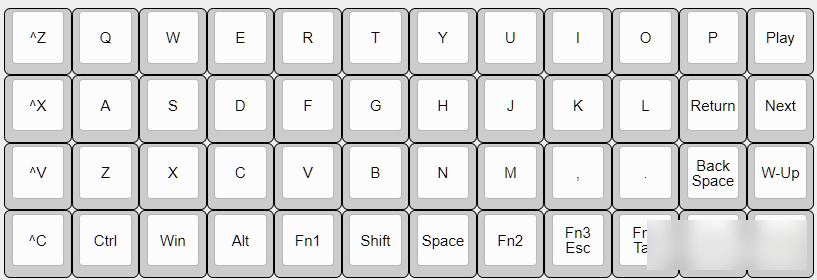Today we only talk about matching, not Fengyue
From the first day of using the keyboard, I was dissatisfied with the anti-human operation method:
Enter, Backspace, and Shift keys are used very frequently, but you need to press the little finger outward; (including common inline keyboards as well)
The huge space bar makes the healthy ten fingers become nine fingers;
Even if there is a large and small keyboard with independent direction keys, the cursor needs to be moved when typing, and the right hand must leave the main keypad;
The number keys are far away, and it is easy to hit them by mistake. I have used it for so long. When designing, I often need to look at the keyboard when typing with the right hand mouse and the left hand;
Except for a few punctuation marks of comma and period, others are not easy to input;
60% of keyboards often don't even have a commonly used independent Del key...
Until recently, I finally solved it after getting into the DIY keyboard. The design principles are as follows: move the wrist as little as possible when inputting, do not need awkward input gestures, and only press two keys to input. Numbers, direction keys, F function keys, etc. hand operation...
The following illustrations may be boring, and one-finger Zen lovers or those who have no intention of trying new things can leave as soon as possible.
Please move to:

Layer 0: letters + function keys, long press Fn1 to enter the number and punctuation layer, Fn2 to enter the arrow keys and punctuation layer, Fn3 for the F function area, virtual mouse, Fn4 for software shortcut keys and media keys. The Enter key is under the little finger of the right hand, and you can press the key without moving; move the little finger down slightly to backspace; the Shift key is in the middle of the bottom line, and press Shift with the left thumb to enter capital letters; put your hands on the main keypad, and use the two thumbs Press Fn1 and Fn2 down to switch Chinese; when typing Chinese with Pinyin input method, press the space with the right thumb to select the first character, press Shift with the left thumb to select the second character, and Fn1+number with the left hand to select other characters, and all operations do not need to leave the main area .

Layer 1: The left side is the numeric keyboard, and the right side is part of the punctuation marks. All punctuation marks are arranged according to personal habits and easy to remember, such as ? It is the F position where Fa asks the question, # is at the J position of the number sign, ~curve q, @at, [bracket Z, {curly bracket K, Na N, $Us knife, "double quotation mark S, ... +-× /= Take into account the use of the numeric keypad. The numeric keypad is suitable for left-handed one-handed operation, including +-×/., backspace, and carriage return, which can be input with one hand without moving the wrist. When I started using this solution, it took a little longer for my left hand to get used to it , but it is still worth it, and now I am very used to the operation method of left-handed numbers and right-handed mouse when designing.

Layer 2: Leftover punctuation marks on the left, arrow keys on the right. Now put both hands on the keyboard, press Fn1 with the left thumb naturally, and feel that there is a numeric keypad underneath, and press Fn2 with the right finger, and feel that there is a directional keyboard underneath, which is very natural and comfortable. If you have an in-line keyboard at hand, you can put your hands on it and try this posture. It is as comfortable as operating a mouse. Moving the cursor during typing is a great experience.

3rd floor: The left side is the spare shortcut keys, F area, and virtual mouse. Press and hold the Fn3 below with the left thumb, and then press the buttons in the middle 4 rows. It is also very easy to operate the F area keys with one hand. (This layer is mainly for backup, I rarely use it)

Layer 4: Arranged for media playback keys and shortcut keys for commonly used software. Fn4+letter is equivalent to Ctrl+Alt+Shift+letter, which can be set as the shortcut key of the software, such as Fn4+C to run Chrome, Fn4+Q to run QQ, Fn4+W to run WeChat, Fn4+M to run music software, Fn4+V to run Video video software... Since using the software shortcut keys, there are no software shortcut icons on the entire computer desktop, and the obsessive-compulsive disorder has been cured.
In short, if you don’t try, you don’t know. After you try: 40-key design, no more, no less, no more , the best choice for simplicity and portability.
The inline keyboard is neatly arranged, so expansion is also very convenient.
If you are a master of Ctrl+C/V, you can have this arrangement: the left side is the independent key of Ctrl+C/V/X/Z, and the right side is my favorite media key.

If you need heavy digital input, you can have this arrangement: the digital pad can be left or right.

40 keys: The simplest programmable inline keyboard with RGB, suitable for beginners
48/64 keys: DIY free combination keyboard: 16, 32, 48, 64 keys (Caution: This plan adopts the extreme wool method)
Pick up in a straight line, obsessed with no regrets!
Factory Adress: No.11,FengpingRoad
